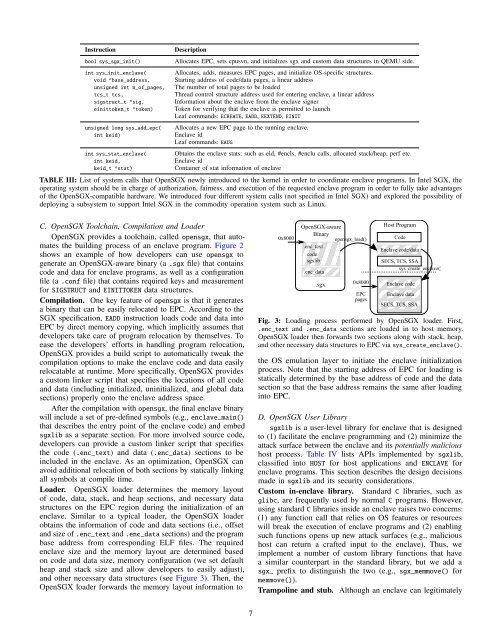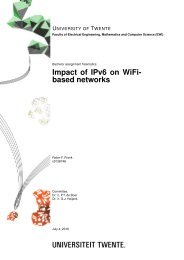Create successful ePaper yourself
Turn your PDF publications into a flip-book with our unique Google optimized e-Paper software.
Instruction<br />
bool sys_sgx_init()<br />
int sys_init_enclave(<br />
void *base_address,<br />
unsigned int n_of_pages,<br />
tcs_t tcs,<br />
sigstruct_t *sig,<br />
einittoken_t *token)<br />
unsigned long sys_add_epc(<br />
int keid)<br />
int sys_stat_enclave(<br />
int keid,<br />
keid_t *stat)<br />
Description<br />
Allocates EPC, sets cpusvn, and initializes sgx and custom data structures in QEMU side.<br />
Allocates, adds, measures EPC pages, and initialize OS-specific structures.<br />
Starting address of code/data pages, a linear address<br />
The number of total pages to be loaded<br />
Thread control structure address used <strong>for</strong> entering enclave, a linear address<br />
In<strong>for</strong>mation about the enclave from the enclave signer<br />
Token <strong>for</strong> verifying that the enclave is permitted to launch<br />
Leaf commands: ECREATE, EADD, EEXTEND, EINIT<br />
Allocates a new EPC page to the running enclave.<br />
Enclave id<br />
Leaf commands: EAUG<br />
Obtains the enclave stats: such as eid, #encls, #enclu calls, allocated stack/heap, perf etc.<br />
Enclave id<br />
Container of stat in<strong>for</strong>mation of enclave<br />
TABLE III: List of system calls that <strong><strong>Open</strong><strong>SGX</strong></strong> newly introduced to the kernel in order to coordinate enclave programs. In Intel <strong>SGX</strong>, the<br />
operating system should be in charge of authorization, fairness, and execution of the requested enclave program in order to fully take advantages<br />
of the <strong><strong>Open</strong><strong>SGX</strong></strong>-compatible hardware. We introduced four different system calls (not specified in Intel <strong>SGX</strong>) and explored the possibility of<br />
deploying a subsystem to support Intel <strong>SGX</strong> in the commodity operation system such as Linux.<br />
C. <strong><strong>Open</strong><strong>SGX</strong></strong> Toolchain, Compilation and Loader<br />
<strong><strong>Open</strong><strong>SGX</strong></strong> provides a toolchain, called opensgx, that automates<br />
the building process of an enclave program. Figure 2<br />
shows an example of how developers can use opensgx to<br />
generate an <strong><strong>Open</strong><strong>SGX</strong></strong>-aware binary (a .sgx file) that contains<br />
code and data <strong>for</strong> enclave programs, as well as a configuration<br />
file (a .conf file) that contains required keys and measurement<br />
<strong>for</strong> SIGSTRUCT and EINITTOKEN data structures.<br />
Compilation. One key feature of opensgx is that it generates<br />
a binary that can be easily relocated to EPC. According to the<br />
<strong>SGX</strong> specification, EADD instruction loads code and data into<br />
EPC by direct memory copying, which implicitly assumes that<br />
developers take care of program relocation by themselves. To<br />
ease the developers’ ef<strong>for</strong>ts in handling program relocation,<br />
<strong><strong>Open</strong><strong>SGX</strong></strong> provides a build script to automatically tweak the<br />
compilation options to make the enclave code and data easily<br />
relocatable at runtime. More specifically, <strong><strong>Open</strong><strong>SGX</strong></strong> provides<br />
a custom linker script that specifies the locations of all code<br />
and data (including initialized, uninitialized, and global data<br />
sections) properly onto the enclave address space.<br />
After the compilation with opensgx, the final enclave binary<br />
will include a set of pre-defined symbols (e.g., enclave_main()<br />
that describes the entry point of the enclave code) and embed<br />
sgxlib as a separate section. For more involved source code,<br />
developers can provide a custom linker script that specifies<br />
the code (.enc_text) and data (.enc_data) sections to be<br />
included in the enclave. As an optimization, <strong><strong>Open</strong><strong>SGX</strong></strong> can<br />
avoid additional relocation of both sections by statically linking<br />
all symbols at compile time.<br />
Loader. <strong><strong>Open</strong><strong>SGX</strong></strong> loader determines the memory layout<br />
of code, data, stack, and heap sections, and necessary data<br />
structures on the EPC region during the initialization of an<br />
enclave. Similar to a typical loader, the <strong><strong>Open</strong><strong>SGX</strong></strong> loader<br />
obtains the in<strong>for</strong>mation of code and data sections (i.e., offset<br />
and size of .enc_text and .enc_data sections) and the program<br />
base address from corresponding ELF files. The required<br />
enclave size and the memory layout are determined based<br />
on code and data size, memory configuration (we set default<br />
heap and stack size and allow developers to easily adjust),<br />
and other necessary data structures (see Figure 3). Then, the<br />
<strong><strong>Open</strong><strong>SGX</strong></strong> loader <strong>for</strong>wards the memory layout in<strong>for</strong>mation to<br />
0x8000<br />
<strong><strong>Open</strong><strong>SGX</strong></strong>-aware<br />
Binary<br />
opensgx_load()<br />
.enc_text<br />
code<br />
sgxlib<br />
.enc_data<br />
.sgx<br />
0x8000<br />
EPC<br />
pages<br />
Host Program<br />
Code<br />
Enclave code/data<br />
SECS, TCS, SSA<br />
sys_create_enclave()<br />
Enclave code<br />
Enclave data<br />
SECS, TCS, SSA<br />
Fig. 3: Loading process per<strong>for</strong>med by <strong><strong>Open</strong><strong>SGX</strong></strong> loader. First,<br />
.enc_text and .enc_data sections are loaded in to host memory.<br />
<strong><strong>Open</strong><strong>SGX</strong></strong> loader then <strong>for</strong>wards two sections along with stack, heap,<br />
and other necessary data structures to EPC via sys_create_enclave().<br />
the OS emulation layer to initiate the enclave initialization<br />
process. Note that the starting address of EPC <strong>for</strong> loading is<br />
statically determined by the base address of code and the data<br />
section so that the base address remains the same after loading<br />
into EPC.<br />
D. <strong><strong>Open</strong><strong>SGX</strong></strong> User Library<br />
sgxlib is a user-level library <strong>for</strong> enclave that is designed<br />
to (1) facilitate the enclave programming and (2) minimize the<br />
attack surface between the enclave and its potentially malicious<br />
host process. Table IV lists APIs implemented by sgxlib,<br />
classified into HOST <strong>for</strong> host applications and ENCLAVE <strong>for</strong><br />
enclave programs. This section describes the design decisions<br />
made in sgxlib and its security considerations.<br />
Custom in-enclave library. Standard C libraries, such as<br />
glibc, are frequently used by normal C programs. However,<br />
using standard C libraries inside an enclave raises two concerns:<br />
(1) any function call that relies on OS features or resources<br />
will break the execution of enclave programs and (2) enabling<br />
such functions opens up new attack surfaces (e.g., malicious<br />
host can return a crafted input to the enclave). Thus, we<br />
implement a number of custom library functions that have<br />
a similar counterpart in the standard library, but we add a<br />
sgx_ prefix to distinguish the two (e.g., sgx_memmove() <strong>for</strong><br />
memmove()).<br />
Trampoline and stub. Although an enclave can legitimately<br />
7







